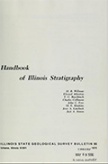Historical:Augusta Member
Lithostratigraphy: Ottawa Limestone Megagroup >>Ancell Group >>Joachim Dolomite >>Augusta Member
Chronostratigraphy: Paleozoic Erathem >>Ordovician System >>Champlainian Series >>Blackriveran Stage
Allostratigraphy: Tippecanoe Sequence
Authors
H. B. Willman and T. C. Buschbach
Name Origin
The Augusta Member of the Joachim Dolomite (Templeton and Willman, 1963, p. 591), which overlies the Abernathy Member, is named for Augusta, Franklin County, Missouri, 5 miles west of the type section.
Type Section
The type section of the Augusta Member is a railroad cut on the south side of the Missouri Valley a mile southwest of St. Albans (SW NE SW 10, 44N-2E), where the member is 29 feet thick.
Extent and Thickness
The Augusta Member extends northward in subsurface as far as southern Calhoun County, Illinois, where it is 16 feet thick. It thickens southward, is generally 50-75 feet thick in the outcrops in Missouri, and is 106 feet thick in a well in Pulaski County, Illinois.
Description
The Augusta Member consists of relatively pure to very silty, light gray, white-weathering dolomite, generally in thick beds. The member contains layers of pure, brown, algal dolomite or limestone. Many individual beds are distinctive and can be widely traced. Locally the basal part is a siltstone or contains layers of green shale, indicative of its facies relation to the upper part of the St. Peter Sandstone. The Augusta is less sandy and the sand is finer grained than that in the Abernathy Member below; it is thicker bedded and less shaly than the Boles above.
References
TEMPLETON, J. S., and H. B. WILLMAN, 1963, Champlainian Series (Middle Ordovician) in Illinois: Illinois State Geological Survey Bulletin 89, 260 p.
ISGS Codes
| Stratigraphic Code | Geo Unit Designation |
|---|---|
